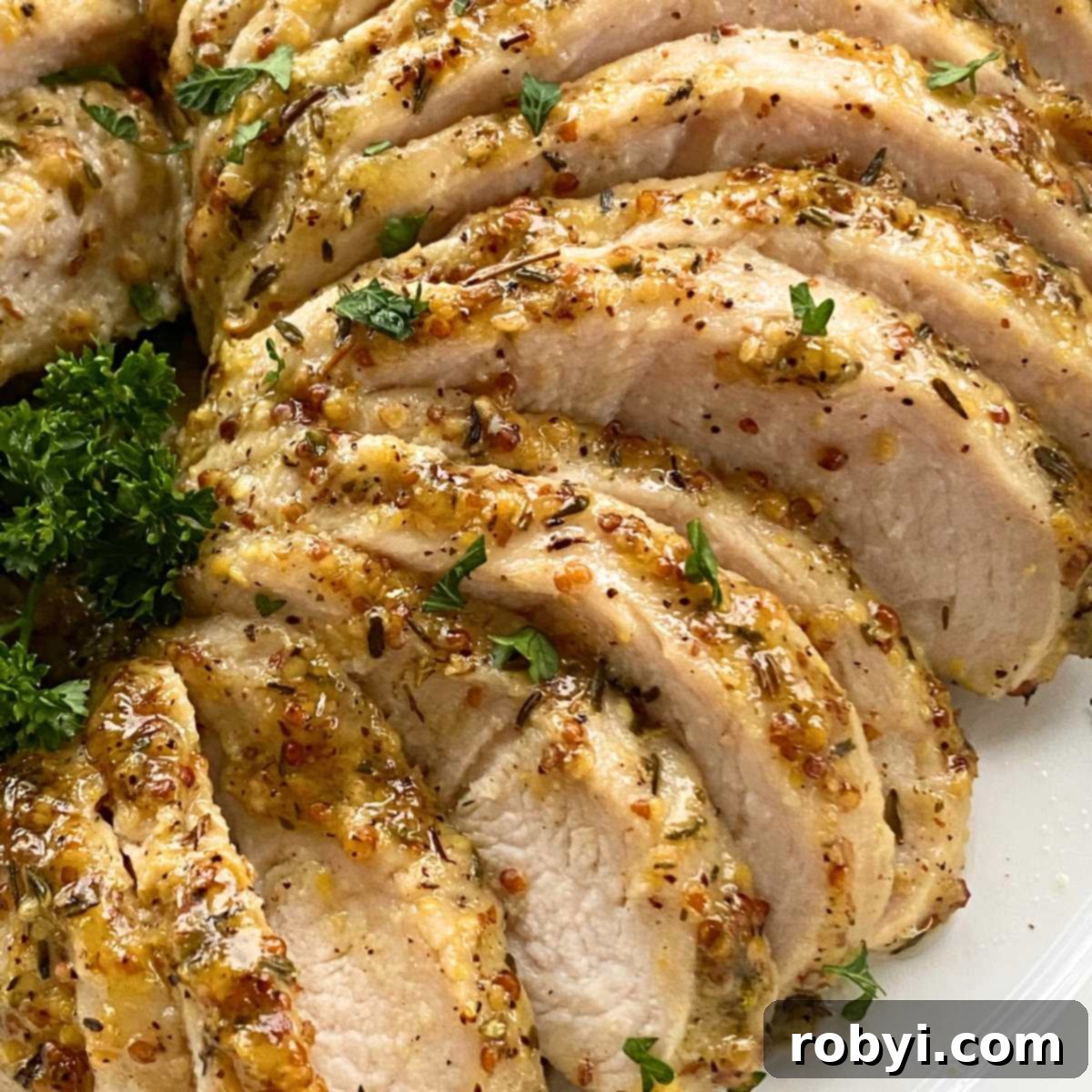Unlock the secret to consistently tender, irresistibly juicy, and profoundly flavorful turkey with this incredibly easy turkey tenderloin marinade recipe. Crafted with a harmonious blend of sweet maple syrup, zesty Dijon mustard, and aromatic garlic, this marinade transforms simple turkey tenderloins into a culinary highlight that’s perfect for any occasion, from quick weeknight dinners to elegant gatherings. Prepare to delight your taste buds with turkey that’s bursting with flavor and moisture!
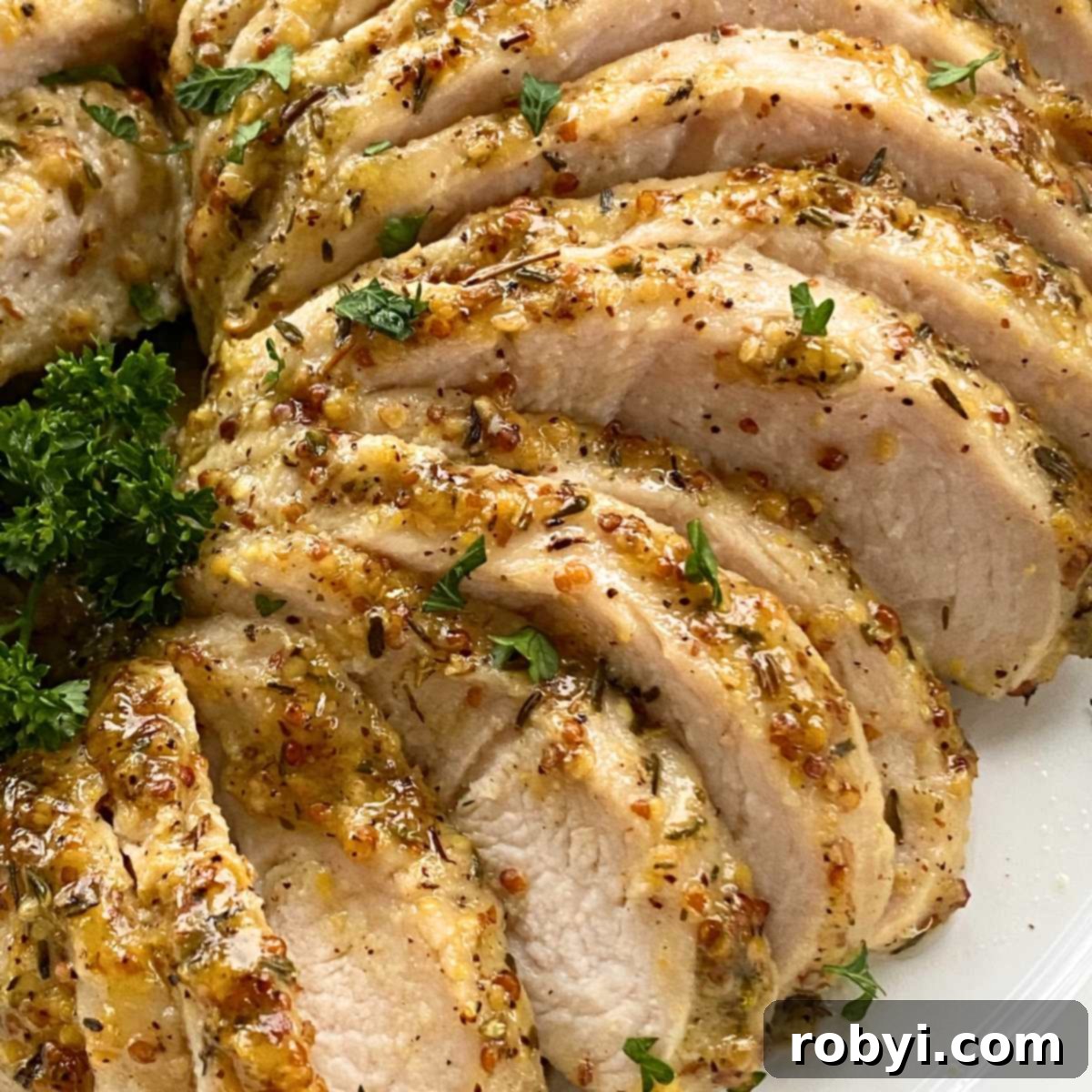
Ever since I first discovered the wonders of turkey tenderloins and began experimenting with their incredible versatility, they’ve become an absolute staple in my kitchen. Gone are the days when herb-crusted turkey tenderloin was reserved exclusively for holiday feasts! These lean, boneless cuts of turkey breast have proven themselves to be a healthy, low-carb, and wonderfully adaptable protein source, earning a permanent spot in our regular dinner rotation.
From simple baked turkey tenderloin rubbed with a medley of spices to this newly beloved sweet and tangy marinade recipe, turkey tenderloins consistently deliver. This particular marinade is nothing short of a flavor explosion in every bite, yet it requires only a handful of readily available, simple ingredients. It’s truly remarkable how such a straightforward combination can yield such profound results, making your turkey exceptionally delicious and memorable.
One of my favorite ways to utilize this marinade is by transforming it into a convenient and wholesome sheet pan meal. Imagine roasting seasonal vegetables like crisp carrots and sweet apples alongside your turkey, all bathed in the same exquisite marinade. As the ingredients cook together on one pan, their flavors meld beautifully, creating a comforting and delightful dish that’s especially perfect for a cool fall or winter night, offering warmth and satisfaction with minimal cleanup.
If you haven’t yet explored the culinary potential of this fantastic cut of turkey, you’re truly missing out! Boneless turkey breast tenderloins not only cook remarkably quickly, making them ideal for busy weeknights, but their meat is also incredibly lean and tender. So tender, in fact, that you can effortlessly slice it with a regular dinner knife, a testament to its delicate texture. And the benefits don’t end there – any delicious leftovers make for outstanding turkey sandwiches the next day, ensuring that every morsel is savored.
Are you ready to impress your family and friends with an easy, show-stopping dinner that’s both healthy and bursting with flavor? Join us as we unveil how to create the best marinade for turkey tenderloins, promising a culinary experience that will redefine your perception of turkey!
Essential Ingredients for a Spectacular Turkey Tenderloin Marinade
Turkey tenderloins are celebrated for their inherent tenderness, a quality that makes them a joy to cook. Given this natural characteristic, the primary objective of this remarkable marinade is not to tenderize, but rather to infuse the meat with an extraordinary depth of flavor, transforming it into an irresistible culinary experience. Here’s a detailed exploration of each simple yet powerful ingredient you’ll need and the crucial role it plays in crafting this unforgettable taste profile:
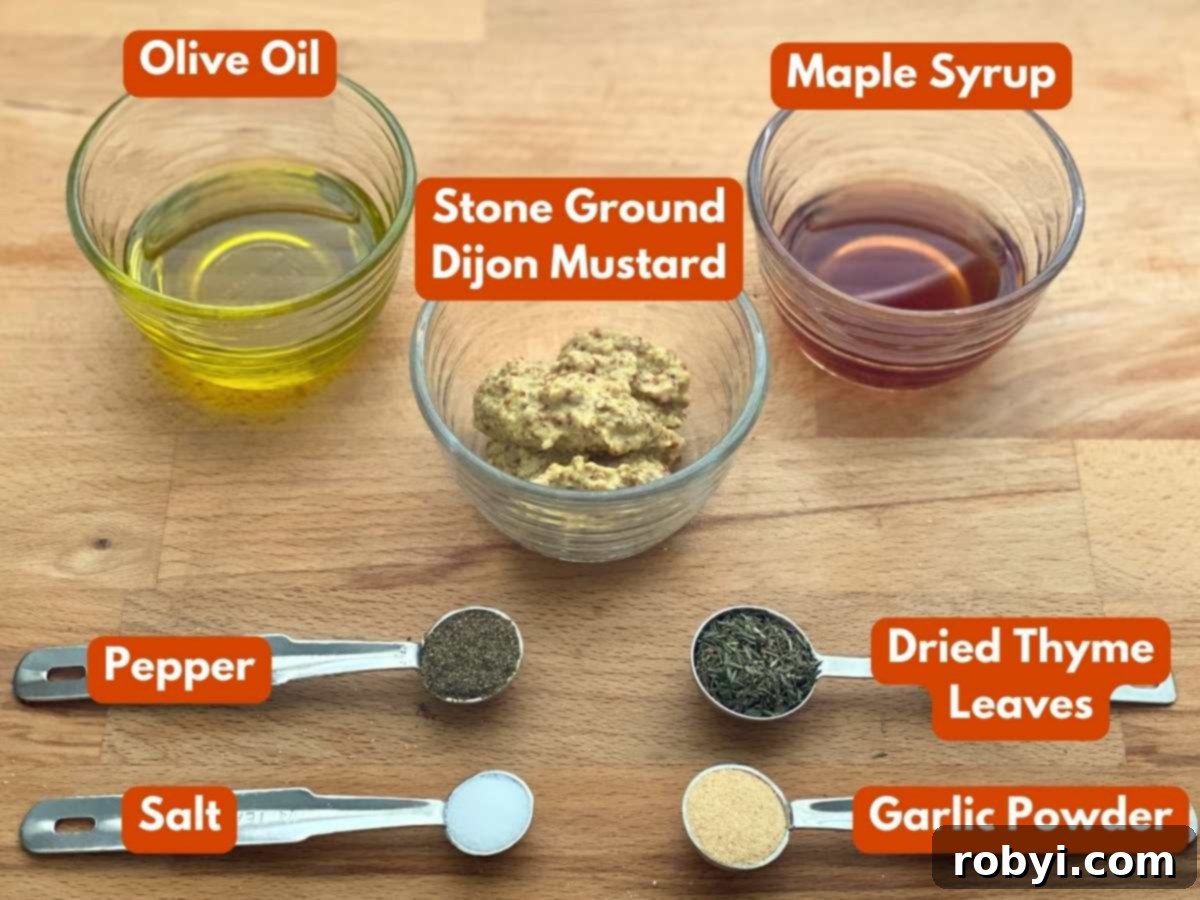
- Olive Oil: This robust and healthy oil forms the fundamental base of our marinade. Beyond its rich flavor, olive oil acts as an excellent emulsifier, ensuring that all the other ingredients are evenly distributed and cling beautifully to the turkey. It also helps to prevent the turkey from sticking during cooking and promotes a lovely golden-brown crust.
- Substitutions: Should olive oil not be available, you can confidently use other neutral-flavored oils. Canola oil, vegetable oil, or avocado oil are all suitable alternatives that will effectively carry the flavors without introducing an overpowering taste of their own.
- Maple Syrup: The heart of this marinade’s sweetness, pure maple syrup provides a distinct, rich, and earthy sweetness that beautifully counteracts the tanginess of the mustard. It also contributes to the appealing caramelization and glossy glaze on the turkey as it cooks, enhancing both flavor and presentation.
- Substitutions: If maple syrup isn’t handy, brown sugar can be used as a viable substitute. When using brown sugar, you’ll want to add about 1 tablespoon of water to the mixture to achieve a consistency similar to that of maple syrup, ensuring the marinade spreads easily. For those adhering to a low-carb or ketogenic diet, fear not! Alternative, low-carb liquid sweeteners made with monk fruit or stevia are excellent options, allowing you to enjoy this delicious recipe while keeping it diet-friendly.
- Stone Ground Dijon Mustard: Also widely recognized as whole grain mustard, this ingredient is a game-changer. It offers a wonderfully coarse texture from the uncrushed mustard seeds, delivering a pungent, tangy kick that perfectly balances the sweetness of the maple syrup. Moreover, its natural acidity, derived from vinegar and white wine, provides a subtle tenderizing effect on the turkey. This not only enhances the flavor profile but also lends a rustic, gourmet appearance to your cooked tenderloin.
- Substitutions: Regular Dijon mustard can be used in place of stone ground Dijon. While it won’t provide the same rustic texture, its tangy flavor profile is a perfect match. However, it’s important to note that yellow mustard, with its significantly milder flavor, is not an ideal substitute as it will drastically alter the intended taste.
- Dried Thyme Leaves: Thyme is an incredibly versatile and aromatic herb that boasts an earthy, slightly minty, and subtly lemon-peppery flavor, making it a classic complement to poultry. It enhances the turkey’s natural taste without overpowering the other marinade components.
- Substitutions: Other popular poultry herbs such as dried rosemary or dried oregano are also excellent options if you’re looking to vary the herbaceous notes. If you prefer using fresh herbs, remember the general rule of thumb: use three times the amount of fresh herbs for every teaspoon of dried herbs (e.g., 3 tablespoons of fresh thyme for 1 teaspoon of dried thyme).
- Garlic Powder or Fresh Garlic Cloves: As is often the case in delicious recipes, garlic is a non-negotiable flavor booster here! It introduces a pungent, savory depth that is essential to the overall profile of this marinade.
- Substitutions: If garlic is unavailable, onion powder can offer a similar savory foundation, though with a slightly different nuance. I often favor garlic powder in marinades because it dissolves effortlessly, ensuring an incredibly even distribution of that robust garlic flavor throughout every inch of the turkey. If using fresh garlic, approximately three medium cloves, finely minced, are equivalent to half a teaspoon of garlic powder.
- Salt and Black Pepper: These foundational seasonings are crucial for amplifying and balancing all the complex sweet, tangy, and savory flavors within the marinade. They bring everything into perfect harmony.
- Important Consideration: It’s vital to check the packaging of your turkey tenderloins, as many commercially processed varieties come in a brining solution that already includes salt. If your turkey is pre-brined, you may need to adjust the amount of salt added to the marinade downwards to prevent your dish from becoming overly salty.
- Turkey Tenderloins: These are the boneless, skinless, and incredibly lean portions of the turkey breast, typically sold in packages containing two individual tenderloins. They are prized for their convenience and quick cooking time. For this particular recipe, we utilized JENNIE-O® All Natural Turkey Breast Tenderloins, which are widely available. You’ll find turkey tenderloins in most larger grocery stores, particularly abundant around the holiday seasons.
- Marinade Versatility: The beauty of this maple Dijon garlic marinade extends beyond turkey tenderloins! It’s exceptionally versatile and can be used to impart incredible flavor to other proteins such as whole turkey breasts, thinner turkey cutlets, chicken breasts, or even pork tenderloin, making it a flexible and indispensable recipe in your culinary arsenal.
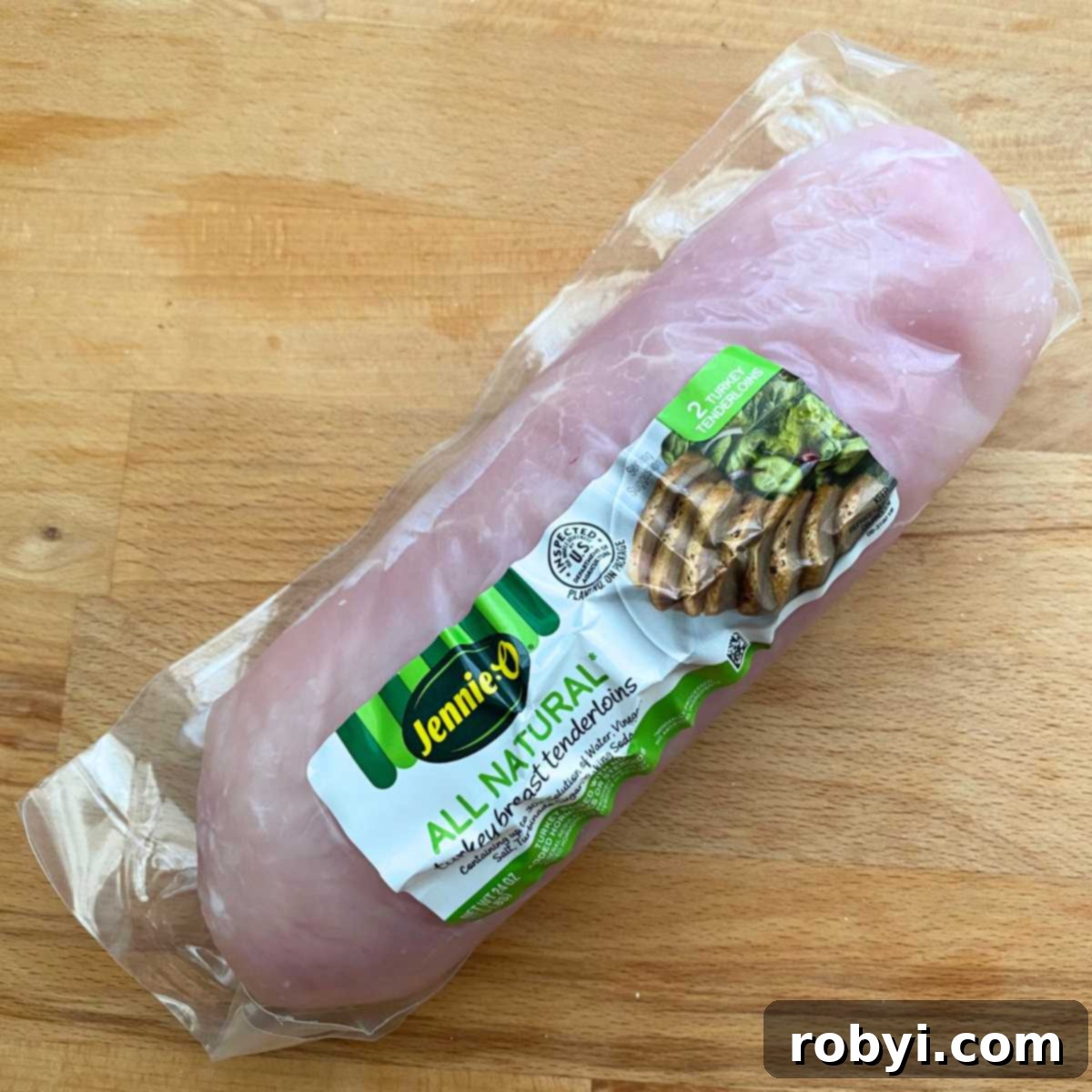
Marinade Yield: This recipe typically produces approximately 10 tablespoons of marinade, which is a generous amount sufficient to thoroughly coat up to 2 pounds of meat. It’s important to understand that while the entire amount is prepared, usually about half of the marinade is left behind in the dish or bag, clinging to the turkey or discarded. Therefore, if you are closely monitoring your calorie or carbohydrate intake, remember to factor this into your calculations.
For the exact measurements of each ingredient and a complete set of detailed instructions, please refer to the comprehensive recipe card located at the bottom of this page.
Step-by-Step Directions for Mastering Marinated Turkey Tenderloins
The beauty of this easy turkey tenderloin recipe lies in its adaptability: whether you choose to bake it in the oven, crisp it in an air fryer, or char-grill it outdoors, the initial preparation and marinating process remains wonderfully consistent. Below, we’ll guide you through each step with clear instructions, complete with visual aids, focusing on the oven-baking method as a primary example to ensure your turkey is infused with maximum flavor and cooked to tender perfection.
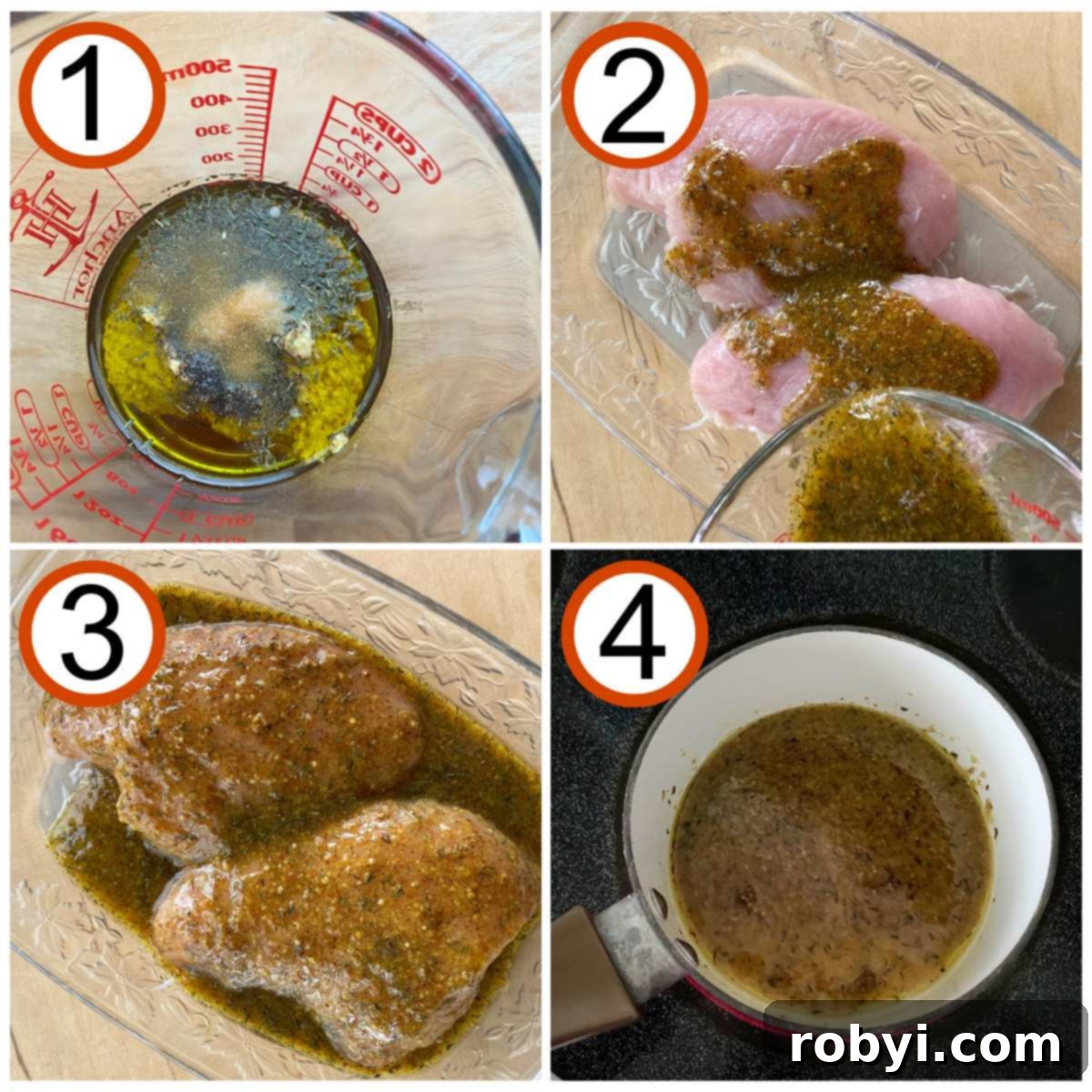
- Combine Marinade Ingredients: In a medium-sized bowl, add all the marinade ingredients: olive oil, maple syrup, stone ground Dijon mustard, dried thyme leaves, garlic powder, salt, and black pepper. Whisk these components vigorously until they are thoroughly combined and form a smooth, uniform mixture. This ensures that every flavor note is perfectly blended and ready to infuse your turkey.
- Marinate the Turkey Tenderloins: Pat the turkey tenderloins thoroughly dry with paper towels. This crucial step is key, as a dry surface allows the marinade to adhere more effectively and penetrate deeper into the meat, resulting in more intense flavor. Place the dried tenderloins into a shallow glass baking dish or a large, sturdy resealable plastic bag. Pour the freshly prepared marinade over the turkey, making sure to flip the tenderloins several times to ensure all sides are generously coated. Cover the dish tightly with plastic wrap or securely seal the bag, then transfer it to the refrigerator.
- Optimal Marinating Time: Allow the turkey to marinate for a minimum of 30 minutes to absorb a good amount of flavor. For an even more profound flavor infusion, you can extend the marinating time to overnight, up to a maximum of 8 hours. If using a plastic bag, flip it periodically during this time; if using a dish, spoon the excess marinade over the top of the tenderloins every so often to ensure consistent coating and maximum flavor absorption.
- Cook the Turkey Tenderloins: Once the marinating process is complete, preheat your oven to 375°F (190°C). You have the option to cook the turkey either in the same glass baking dish used for marinating (ensure it is oven-safe) or by transferring them to a clean, rimmed baking sheet. There is absolutely no need to brush or wipe off the marinade before cooking! The marinade will continue to work its magic as it bakes, transforming into a delectable, glossy glaze that adds both flavor and visual appeal to your finished dish. Bake for approximately 25 to 30 minutes, or until an internal meat thermometer inserted into the thickest part of the turkey registers a safe temperature of 165°F (74°C).
- Food Safety Advisory: Any marinade that has come into contact with raw meat must be discarded immediately after use to prevent cross-contamination. If you wish to utilize some of the excess marinade as a serving sauce, it is imperative to sanitize it properly. To do this, transfer the excess marinade to a small saucepan and bring it to a vigorous rolling boil for at least 5 minutes, ensuring all harmful bacteria are destroyed before serving.
- Rest and Enjoy: Once cooked, remove the turkey tenderloins from the oven and transfer them to a cutting board. It is absolutely essential to allow them to rest for at least 5 minutes before you begin slicing. This critical resting period permits the juices within the meat to redistribute evenly throughout the tenderloins, ensuring that every slice is incredibly moist, tender, and flavorful. Skipping this step can result in dry turkey as the juices will escape when cut. After resting, slice and savor your perfectly cooked, maple-Dijon infused turkey!
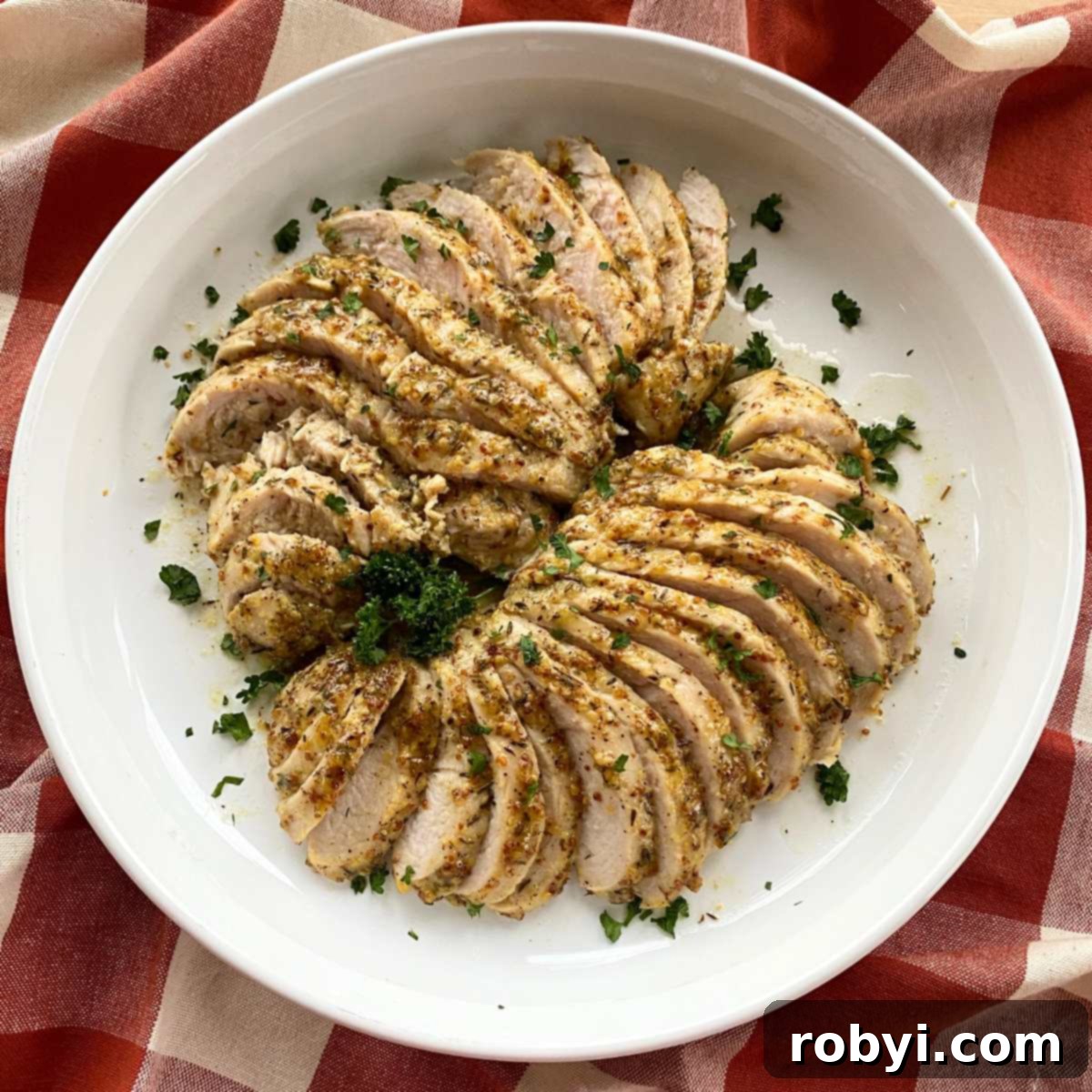
Top Tip: The Secret to Consistently Juicy and Safe Turkey Tenderloins
Achieving perfectly cooked turkey tenderloins that are both incredibly juicy and safe to eat hinges on one critical factor: precise temperature control. According to the FDA, poultry, including turkey, is considered safely cooked once it reaches an internal temperature of 165°F (74°C). However, the exact amount of time this takes can fluctuate significantly. Factors such as the initial temperature and thickness of your turkey tenderloins, the specific wattage and efficiency of your air fryer, or the calibration of your oven or grill can all influence cooking duration.
To consistently guarantee turkey that is perfectly cooked – moist and tender rather than dry and tough, and always safe for consumption – we cannot stress enough the importance of using a reliable meat thermometer. Insert the thermometer into the thickest part of the turkey, being careful to avoid any bones (though tenderloins are boneless, ensure you’re in the center of the meat). This is the single most accurate and reliable method to monitor doneness. The moment your thermometer reads 165°F, your turkey is ready! Promptly remove it from the heat source to prevent overcooking, which is the most common cause of dry turkey. Investing in a good quality instant-read thermometer is an invaluable tool for any home cook, ensuring consistently delicious and stress-free results every time.

Delicious Side Dishes: The Perfect Companions for Maple Dijon Turkey Tenderloin
This incredibly flavorful maple Dijon turkey tenderloin is wonderfully versatile, pairing exquisitely with a vast array of side dishes. This makes it an ideal main course for any season, effortlessly transitioning from a casual weeknight family dinner to a more elaborate and impressive gathering. Here are some healthy, vibrant, and utterly delicious suggestions to help you craft a perfectly balanced and unforgettable menu:
- Roasted Vegetables (Sheet Pan Meal): For ultimate convenience and cohesive flavor, transform your meal into a delightful sheet pan experience. Hearty vegetables like Brussels sprouts, carrots, or a colorful medley of bell peppers, zucchini, and red onions roast beautifully alongside the turkey. Simply toss your chosen veggies with a drizzle of olive oil, a pinch of salt and pepper, and a bit of the turkey marinade (ensuring it’s fresh and hasn’t touched raw meat, or use a separate batch). Roasting everything on the same pan creates a deeply flavorful dish with minimal cleanup.
- Creamy Mashed Potatoes: A universally loved comfort food, creamy mashed potatoes are always a crowd-pleaser. Their smooth texture and ability to soak up the rich, savory turkey juices make them an ideal and satisfying accompaniment.
- Mashed Cauliflower: For a lighter, healthier, and low-carb alternative to traditional mashed potatoes, mashed cauliflower is an excellent choice. It can be whipped up in mere minutes, especially when utilizing convenient frozen cauliflower florets. Take it a step further by incorporating fresh spinach or kale to create a vibrant and nutritious cauliflower colcannon.
- Low-Sugar Cranberry Sauce: Don’t limit cranberry sauce to just Thanksgiving! A bright, tangy, and naturally sweetened low-sugar cranberry sauce offers a fantastic burst of freshness and a delightful tart counterpoint that brilliantly cuts through the richness of the turkey and the sweetness of the maple.
- Crispy Roasted Green Beans: Simple, wholesome, and incredibly satisfying, crispy roasted green beans – whether prepared in the oven or air fryer – provide a wonderful textural contrast and a vibrant green pop of color to your plate.
- Classic Dressing or Stuffing: Especially comforting during cooler months or for a more traditional meal, a homemade oven-baked stuffing or dressing with its savory bread base and aromatic herbs provides a hearty and delightful balance to the lean turkey.
- Farro Pilaf: A nutritious and flavorful alternative to rice, farro pilaf offers a delightful chewy texture and a subtle, nutty flavor that complements the turkey’s profile beautifully.
- Steamed or Roasted Broccoli or Cauliflower: Sometimes, simplicity is best. Lightly steamed, roasted, or gently sautéed broccoli or cauliflower florets are always a healthy, straightforward, and delicious choice. For a creative and kid-friendly twist, consider serving bite-sized broccoli muffins!
- Roasted Asparagus: Elegant and remarkably easy to prepare, tender roasted asparagus spears drizzled with a touch of balsamic glaze, a squeeze of fresh lemon juice, or a sprinkle of grated Parmesan cheese make for a sophisticated and delectable pairing.
- Sautéed Baby Carrots with Garlic: Sweet, tender, and infused with savory garlic, sautéed baby carrots are a simple yet incredibly flavorful side dish that enhances the natural sweetness present in the maple marinade.
- Roasted Cauliflower Rice: For a low-carb, grain-free accompaniment, roasted cauliflower rice is wonderfully fluffy and delicious. It offers a light texture and can even be roasted on the same sheet pan as your turkey for added convenience.
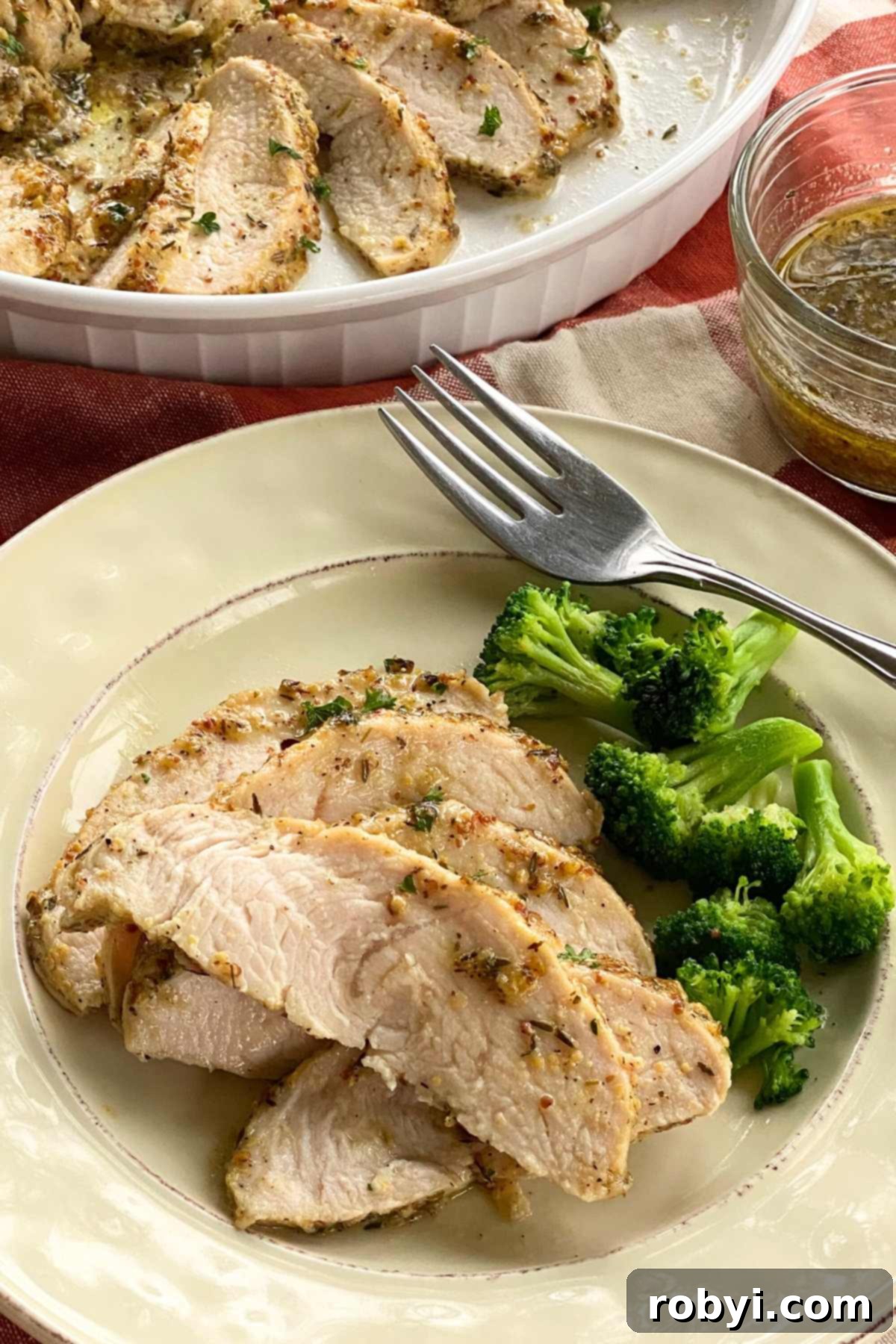
Storage and Reheating Tips for Delicious Leftover Turkey Tenderloin
Maximizing the lifespan and deliciousness of your leftover maple Dijon turkey tenderloin is simple with these practical storage and reheating recommendations, ensuring your efforts in the kitchen don’t go to waste:
- Proper Storage: Once your turkey tenderloins are fully cooked and have cooled down to room temperature, promptly transfer them to an airtight container. Alternatively, you can use a high-quality, heavy-duty freezer bag, ensuring as much air as possible is squeezed out before sealing. Stored correctly in the refrigerator, the cooked turkey tenderloins will maintain their freshness and flavor for up to 3 to 5 days. For longer-term preservation, you can freeze them for up to 2 months. Always remember to label your containers or bags with the date to keep track of freshness.
- Gentle Reheating: The key to reheating leftover turkey without it becoming dry, tough, or rubbery is to do so gently and with added moisture. We highly recommend incorporating a small amount of liquid, such as a tablespoon or two of chicken or turkey broth, to the bottom of your reheating dish. Covering the dish tightly is also crucial, as it traps the steam and moisture, helping to keep the turkey succulent.
- Oven Reheating Method: Preheat your oven to a moderate 325°F (160°C). Place the turkey and broth in a covered, oven-safe dish and reheat until the internal temperature of the turkey reaches a safe 165°F (74°C). This slower, more even heating method is ideal for maintaining tenderness.
- Microwave Reheating Method: For a quicker option, place the turkey and broth in a microwave-safe dish, cover, and reheat in the microwave at 50% power. Use short intervals (e.g., 30-60 seconds at a time), checking and flipping the turkey if necessary, until it is heated through. Reheating at a lower power setting and in short bursts significantly helps to prevent overcooking, which is often the culprit behind dry, rubbery microwave-reheated meat.
Frequently Asked Questions About Turkey Tenderloin Marinade
For optimal flavor infusion using this maple Dijon marinade, we recommend marinating turkey tenderloins for at least 30 minutes. This duration is sufficient for the primary flavors to begin permeating the meat. However, for a truly profound and deeply absorbed taste, you can extend the marinating time to overnight, ideally up to a maximum of 8 hours. While this specific marinade is not excessively acidic (meaning it’s less likely to break down the meat rapidly compared to highly acidic marinades), marinating for much longer than 8 hours, especially with other marinade types, can sometimes lead to a slight alteration in meat texture, potentially making it too soft or “mushy.” For this recipe, the 8-hour mark strikes a perfect balance between maximum flavor development and maintaining the turkey’s desirable texture.
Searing turkey tenderloin before transferring it to the oven is an optional step that can contribute to a more pronounced browned exterior and a deeper, richer “locked-in” flavor, as well as providing an appealing visual crust. If you opt to sear, it’s advisable to gently brush off any significant excess marinade beforehand, particularly if you’re using stone ground mustard. The small mustard seeds in stone ground varieties can sometimes burn or char too quickly at the high temperatures required for searing. To sear, heat about one tablespoon of olive oil in an oven-safe skillet over medium-high heat until shimmering. Brown the turkey tenderloins for 2-3 minutes on each side until a golden crust forms. However, for this particular maple Dijon garlic marinade, we’ve found that searing isn’t strictly necessary. The marinade itself is relatively thick and develops into a beautiful, glossy, and flavorful glaze as the turkey bakes in the oven, naturally creating a wonderful crust without the need for an additional searing step. This saves time and cleanup without sacrificing flavor.
This easy maple Dijon marinade recipe is perfectly suited for creating deliciously tender and perfectly browned air-fried turkey tenderloins. The air fryer excels at crisping the exterior while ensuring the inside remains incredibly tender and juicy. Here’s a detailed guide on how to adapt the recipe for your air fryer:
1. Prepare & Marinate: Follow the standard preparation and marinating instructions (steps 1 and 2 in the main directions above). Ensure your turkey tenderloins are marinated for at least 30 minutes, or up to 8 hours for enhanced flavor.
2. Preheat Air Fryer: Preheat your air fryer to 350°F (175°C) for approximately 5 minutes. This ensures the air fryer is at optimal temperature for immediate cooking.
3. Load the Air Fryer: Lightly spritz the air fryer basket with cooking oil or a non-stick spray to prevent any sticking. Carefully lift the turkey tenderloins out of the marinade, allowing any significant excess marinade to drip off. Place the tenderloins in a single layer within the air fryer basket. It’s crucial not to overcrowd the basket, as proper air circulation is vital for even cooking and crisping. You may need to cook the tenderloins in two or more batches, depending on the size of your air fryer.
4. Cooking Time: Cook the turkey tenderloins for approximately 20-25 minutes. Make sure to flip the tenderloins halfway through the cooking time (around the 10-12 minute mark) to ensure even browning and thorough cooking on all sides. Always use an instant-read meat thermometer to check for doneness. Insert it into the thickest part of the turkey, and continue cooking until it registers an internal temperature of 165°F (74°C).
5. Rest: Just as with oven baking, allow the air-fried turkey tenderloins to rest for a full 5 minutes before slicing and serving. This resting period is critical for the juices to redistribute, resulting in the most tender and moist turkey possible. As always, remember to discard any unused marinade that has touched raw meat, or follow the safe sanitization steps if you intend to use it as a sauce.
Yes, you can certainly use frozen turkey tenderloins for this recipe, but it is absolutely essential to thaw them completely before you begin the marinating process. Freezing and thawing can sometimes cause minor changes in meat texture, but proper thawing ensures that the marinade penetrates effectively and the turkey cooks evenly and safely. To thaw, transfer the frozen tenderloins to the refrigerator 24 to 48 hours in advance, allowing them to slowly and safely defrost. If you are short on time, you can use the cold water thawing method: place the sealed package of frozen turkey in a bowl of cold water, changing the water every 30 minutes, until fully thawed. Never attempt to marinate or cook partially frozen meat, as this can lead to uneven flavor absorption and potential food safety issues due to inconsistent cooking temperatures.
This marinade, when paired with lean turkey tenderloins, is inherently a healthy choice due to several factors. Turkey tenderloins are an excellent source of lean protein, which is vital for muscle repair and satiety, while being naturally low in unhealthy fats. The base ingredients of the marinade, such as olive oil, fresh or powdered garlic, and dried herbs like thyme, contribute beneficial nutrients and antioxidants without adding excessive calories. For individuals following a low-carb or ketogenic diet, the primary adjustment needed is regarding the sweetener. While the original recipe calls for maple syrup, you can easily adapt this by substituting it with a low-carb liquid sweetener like monk fruit syrup or a stevia blend. This modification allows you to retain the delicious sweet-tangy balance of the marinade while significantly reducing the carbohydrate content. The Dijon mustard and a generous blend of herbs remain perfectly low-carb flavor enhancers, making this a highly versatile and diet-friendly recipe that doesn’t compromise on taste or health benefits.
Hungry for more easy, healthy, and carb-conscious recipes to simplify your meal planning?
📋 Recipe: Easy Maple Dijon Garlic Turkey Tenderloin
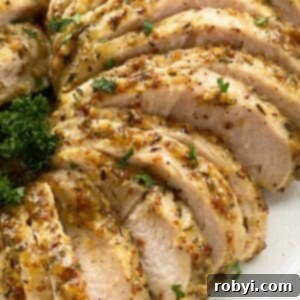
Easy Turkey Tenderloin Marinade Recipe
Craft this incredibly easy turkey tenderloin marinade with maple syrup, Dijon mustard, and garlic for irresistibly juicy and flavorful turkey! Perfect for baking, air frying, or grilling.
Prep Time: 5 minutes
Cook Time: 25 minutes
Marinating Time: 30 minutes (up to 8 hours)
Total Time: Approximately 1 hour (including minimum marination)
Servings: 6 servings
Author: Marjory Pilley
Ingredients
- ¼ cup olive oil
- ¼ cup maple syrup (or brown sugar + 1 tablespoon water; low-carb sweetener can be used)
- 3 tablespoons stone ground Dijon mustard (or regular Dijon mustard)
- 1 teaspoon dried thyme leaves (or 1 tablespoon fresh thyme leaves)
- ½ teaspoon garlic powder (or 3 minced garlic cloves)
- ¼ teaspoon salt
- ½ teaspoon black pepper
- 1.5 pounds turkey tenderloins (typically 2 tenderloins per package)
Instructions
- Combine all marinade ingredients (olive oil, maple syrup, mustard, thyme, garlic powder, salt, pepper) in a medium bowl and whisk until well combined and smooth.
- Pat turkey tenderloins thoroughly dry with paper towels. Place them in a glass baking dish or a large resealable plastic bag. Pour the prepared marinade over the turkey, ensuring all sides are generously coated. Cover the dish or seal the bag tightly and transfer to the refrigerator.
- Marinate for a minimum of 30 minutes for good flavor, or up to 8 hours for a more intense taste. If using a bag, flip it halfway through; if using a dish, spoon excess marinade over the top periodically.
- Preheat your oven to 375°F (190°C).
- Remove turkey from the marinade, allowing any excess to drip off (do not wipe clean). Place the tenderloins in a glass baking dish or on a clean, rimmed baking sheet. Bake for about 25-30 minutes, or until an internal meat thermometer inserted into the thickest part reads 165°F (74°C). (Refer to the main article for important steps on safely using leftover marinade as a side sauce.)
- Allow the cooked turkey tenderloins to rest for 5 minutes before slicing. This crucial resting period allows the juices to redistribute throughout the meat, ensuring maximum tenderness and moisture. Then, slice and enjoy!
Notes
- Additional Guidance: For step-by-step photos, variations, and extensive serving ideas, please refer to the detailed sections provided earlier in this article.
- Marinade Volume: This recipe yields approximately 10 tablespoons of marinade, which is sufficient for up to 2 pounds of meat. Please note that approximately half of this marinade is typically left behind after marinating and cooking, but the full amount is included in the initial nutritional calculations. Consider this if tracking specific dietary macros.
- Accurate Cooking: Always use a reliable meat thermometer, inserted into the thickest part of the turkey, to ensure it reaches an internal temperature of 165°F (74°C). This is the best method to guarantee both food safety and prevent overcooking, resulting in perfectly tender meat.
- Storage: Store any leftover cooked and cooled turkey tenderloins in an airtight container or a sealed bag in the refrigerator for up to 5 days, or in the freezer for up to 2 months.
- Reheating: To reheat, place leftover turkey in an oven preheated to 325°F (160°C) with a splash of broth and covered, until an internal temperature of 165°F (74°C) is reached. Alternatively, microwave on 50% power in short intervals, covered, to prevent drying out.
Nutrition Information (per serving)
- Calories: 243 kcal
- Carbohydrates: 10g
- Protein: 27g
- Fat: 11g
- Saturated Fat: 2g
- Polyunsaturated Fat: 1g
- Monounsaturated Fat: 7g
- Trans Fat: 0.002g
- Cholesterol: 51mg
- Sodium: 257mg
- Potassium: 49mg
- Fiber: 0.4g
- Sugar: 8g
- Vitamin A: 22 IU
- Vitamin C: 1mg
- Calcium: 22mg
- Iron: 0.3mg
Nutritional and Food Safety Disclaimer
